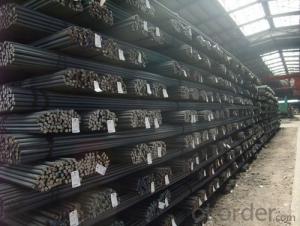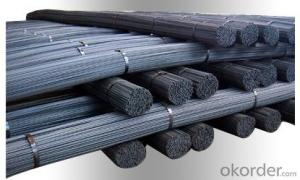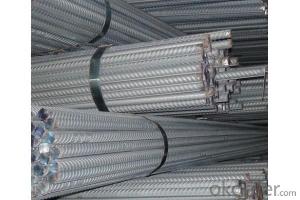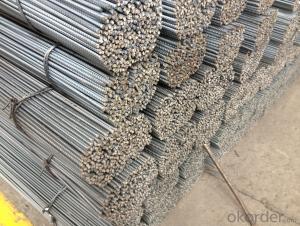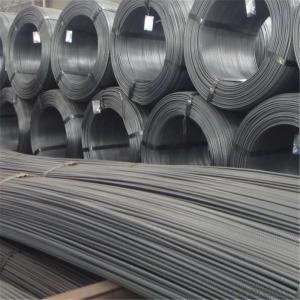High Quality Steel Rebar
- Loading Port:
- China Main Port
- Payment Terms:
- TT OR LC
- Min Order Qty:
- -
- Supply Capability:
- -
OKorder Service Pledge
Quality Product, Order Online Tracking, Timely Delivery
OKorder Financial Service
Credit Rating, Credit Services, Credit Purchasing
You Might Also Like
Quick Details
Standard:AISI, ASTM, BS, DIN, GB, JIS
Grade:HRB335
Diameter:6mm-15mm
Length:6m,9m,12m or others
Place of Origin:China (Mainland)
Model Number:001
Application:building
Packaging & Delivery
| Packaging Details: | bundle with steel wire rod |
|---|---|
| Delivery Detail: | 15-30 days after get your deposit. |
- Q: Can steel rebars be used in foundation structures?
- Yes, steel rebars can be used in foundation structures. In fact, they are commonly used in reinforced concrete foundations to increase the strength and durability of the structure. Steel rebars provide reinforcement to the concrete by enhancing its tensile strength, which is particularly important in areas where the foundation might be subjected to heavy loads or seismic activity. The rebars are typically placed in a grid pattern within the concrete to distribute the load and prevent cracking or failure. Overall, steel rebars are an essential component in foundation structures to ensure their stability and longevity.
- Q: Are steel rebars resistant to fire?
- Yes, steel rebars are generally resistant to fire due to their high melting point and low thermal conductivity.
- Q: What are the different types of steel rebars used in road construction?
- Road construction utilizes various types of steel rebars, each possessing unique characteristics and advantages. Some commonly employed variants encompass: 1. Mild Steel Rebars: These, also recognized as carbon steel rebars, represent the prevailing choice in road construction. With a low carbon content and affordability, they are suitable for diverse applications, offering commendable strength and ductility. 2. High Strength Deformed (HSD) Rebars: Distinguishing themselves through enhanced tensile strength in comparison to mild steel rebars, these are produced by mechanically treating mild steel bars, including hot rolling, quenching, and tempering. HSD rebars satisfy the demand for elevated load-bearing capacity, such as in bridge construction. 3. Stainless Steel Rebars: Boasting a high chromium content, these rebars possess corrosion resistance. They prove particularly advantageous in regions with high humidity, coastal areas, or locations exposed to corrosive substances, albeit at a higher cost compared to alternative types. Their allure lies in long-term durability. 4. Epoxy-Coated Rebars: For protection against corrosion, these rebars undergo epoxy coating. This coating creates a barrier, safeguarding the steel from the environment and moisture, thereby preventing penetration by corrosive elements. In concrete pavements, epoxy-coated rebars extend road longevity. 5. Galvanized Rebars: These rebars undergo zinc coating, affording them protection against corrosion. The zinc layer acts sacrificially, preventing the steel from encountering corrosive elements. Road construction projects necessitating corrosion resistance, particularly in moist or chemically-exposed areas, commonly employ galvanized rebars. Selecting the appropriate steel rebars for road construction projects hinges upon specific requirements. Factors such as load-bearing capacity, environmental conditions, and budgetary considerations significantly influence the rebars' optimal type.
- Q: How are steel rebars connected or joined together during construction?
- Steel rebars are typically connected or joined together during construction using a variety of methods and techniques. The most common method is by overlapping the rebars and tying them together using steel wire. This process is known as rebar tying or wire tying. To ensure a strong and secure connection, the rebars are overlapped at a certain length, typically between 40 to 60 times the diameter of the rebars. The overlapping length allows for the transfer of load and ensures structural integrity. Once the rebars are properly overlapped, steel wire is tightly wrapped around the intersection point to hold them together. Another method of connecting rebars is by using mechanical couplers. Mechanical couplers are pre-fabricated devices that are used to join two rebars together. These couplers provide a threaded connection, allowing for a more precise and efficient joining process. The rebars are inserted into the couplers, and then the couplers are tightened using a wrench or other appropriate tool. Welding is also used to connect rebars, especially in larger construction projects. Welding involves melting the rebars at the intersection point and fusing them together using heat and pressure. This method provides a strong and permanent connection, but it requires skilled labor and proper safety precautions to ensure the quality of the weld. Furthermore, in some cases, rebars can be connected using epoxy bonding. Epoxy bonding involves applying an adhesive material to the surface of the rebars and then pressing them together. The epoxy acts as a bonding agent, creating a strong and durable connection between the rebars. The method of connecting rebars during construction depends on various factors such as the size of the rebars, the specific requirements of the project, and the construction techniques being used. It is essential to follow industry standards and guidelines to ensure the proper connection and integrity of the rebars, as they play a critical role in reinforcing concrete structures.
- Q: What is the role of steel rebars in ensuring occupant safety?
- Steel rebars play a crucial role in ensuring occupant safety in various structures, particularly in buildings and infrastructure. These reinforced steel bars are commonly used in concrete construction to enhance the strength and durability of the structure, ultimately safeguarding the individuals residing or working within them. The primary function of steel rebars is to provide structural reinforcement to concrete elements, such as columns, beams, and slabs. By incorporating rebars into the concrete, the overall load-bearing capacity of the structure is significantly increased, allowing it to withstand various external forces and loads. This greatly reduces the risk of collapse or structural failure, which could potentially harm the occupants. During seismic events, such as earthquakes, steel rebars play a critical role in dissipating and distributing the energy exerted on the structure. The ductility and tensile strength of steel allow it to absorb and distribute the seismic forces, reducing the chances of a sudden structural failure. This ensures that the occupants are protected from the potential hazards associated with seismic activity. Moreover, steel rebars enhance the fire resistance of concrete structures. While concrete itself possesses good fire-resistant properties, the inclusion of steel rebars further reinforces this resistance. Steel has a high melting point, and its thermal conductivity is relatively low compared to other materials. This means that steel rebars can withstand high temperatures for an extended period, ensuring the structural integrity of the building during a fire and providing occupants with a safe evacuation route. In addition to their structural benefits, steel rebars also contribute to the long-term durability and maintenance of the structure. By preventing cracks and minimizing the effects of corrosion, rebars help maintain the structural integrity of the concrete over time. This ensures that the occupants are not exposed to potential hazards caused by the deterioration of the structure. Overall, the role of steel rebars in ensuring occupant safety is indispensable. They provide structural reinforcement, increase load-bearing capacity, enhance fire resistance, and contribute to the long-term durability of a structure. By incorporating steel rebars into concrete construction, the risk of collapse, structural failure, and other potential hazards is significantly reduced, ultimately providing a safe environment for the occupants.
- Q: What is the resistance of steel rebars against acid attacks?
- Steel rebars have a high resistance against acid attacks due to their inherent corrosion-resistant properties. The steel's protective oxide layer helps prevent the acid from penetrating and causing significant damage to the rebars. However, prolonged exposure to highly concentrated or aggressive acids may eventually lead to corrosion, necessitating appropriate protective measures.
- Q: Are there any alternatives to steel rebars?
- Yes, there are several alternatives to steel rebars. One alternative is the use of fiber-reinforced polymer (FRP) rebars, which are made of high-strength fibers embedded in a polymer matrix. FRP rebars offer several advantages over traditional steel rebars, including corrosion resistance, high tensile strength, and lightweight properties. They are also non-magnetic and electrically non-conductive, making them suitable for areas with electromagnetic interference concerns. Another alternative is the use of basalt rebars, which are made from basalt rock fibers. Basalt rebars offer similar benefits as FRP rebars, including corrosion resistance and high tensile strength. Additionally, some manufacturers have developed alternative materials such as bamboo, carbon fiber, and glass fiber rebars, which have also shown promise in certain applications. However, it is important to note that the choice of alternative rebars depends on the specific requirements of a project, and factors such as cost, availability, and local building codes should be considered when selecting an alternative to steel rebars.
- Q: What are the different methods of joining steel rebars?
- Some different methods of joining steel rebars include overlap splicing, mechanical couplers, welded splices, and threaded splices. These methods ensure a strong and reliable connection between the rebars, which is essential for reinforcing concrete structures.
- Q: Can steel rebars be used in retaining walls and dams?
- Yes, steel rebars can be used in retaining walls and dams. Steel rebars are commonly used in construction projects as reinforcement to provide strength and stability to concrete structures. In retaining walls and dams, where the primary objective is to withstand high pressure and heavy loads, steel rebars are often incorporated to enhance the structural integrity and durability of these structures.
- Q: Can steel rebars be used in structures with high sulfate content in soil or water?
- Steel rebars should generally not be used in structures with high sulfate content in soil or water. Sulfates can react with the steel and cause it to corrode rapidly, leading to structural damage and potential failure. To mitigate this risk, alternative materials such as stainless steel or fiber-reinforced polymer rebars may be recommended for use in such environments.
Send your message to us
High Quality Steel Rebar
- Loading Port:
- China Main Port
- Payment Terms:
- TT OR LC
- Min Order Qty:
- -
- Supply Capability:
- -
OKorder Service Pledge
Quality Product, Order Online Tracking, Timely Delivery
OKorder Financial Service
Credit Rating, Credit Services, Credit Purchasing
Similar products
Hot products
Hot Searches
Related keywords






